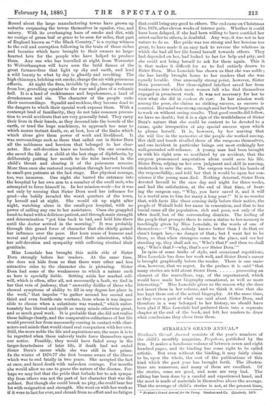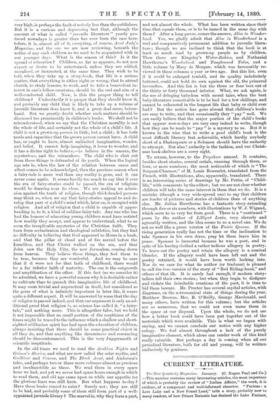STRAHAN'S GRAND ANNUAL.* St; ahan's Grind Annual consists of the
year's numbers of the child's monthly magazine, Peepshow, published by the firm. It makes a handsome volume of between seven and eight hundred pages, and its binding has some right to be called artistic. But even without the binding, it may fairly claim to be, upon the whole, the best of the publications of this kind which the past year has brought forth. The illustra- tions are numerous, and many of them are excellent. Of the stories, some are good, and none are very bad. The editing has been done by a careful and experienced hand, and the most is made of materials in themselves above the average. That the average of child's stories is not, at the present time,
• &rahan's Grand Annual for the Young. Straban and Co. (Limited). 1879. very high, is perhaps the fault of nobody less than the publishers. But it is a curious and depressing fact that, although the amount of what is called " juvenile literature " yearly pro- duced nowadays is greater than has ever been the case here- tofore, it is, almost all of it, excepting, of course, Aunt Judy's Magazine, and the one we are now reviewing, beneath the notice of any such children as we used to be acquainted with in our younger days. What is the reason of this ? Is it the spread of education ? Children, as far as appears, do not now expect or desire to be entertained, unless they are edified, moralised, or instructed, at the same time. They wish to be told, when they take up a story-book, that life is a serious matter, that everything is either right or wrong, that to attend church, to study lessons, to work, and to take a benevolent in- terest in one's fellow-creatures, should be the end and aim of a well-conducted child. Now, is this the proper thing to tell children? Undoubtedly it is proper that they should know it, and probably any child that is likely to take up a volume of juvenile literature does know it, and a great deal more, before- hand. But we greatly doubt whether such matters should be discussed too prominently in children's books. We shall not be misunderstood, when we say that the Christian morality is not the whole of life, and certainly not the whole of a child's life. A child is not a grown-up person in little, but a child ; it has both needs and capacities that the grown person cannot have. A child has, or ought to have, almost unlimited imagination, wonder, and belief. It cannot help imagining, it loves to wonder, and it has a divine right to believe,—to believe in the unseen, the mysterious, and the miraculous. The child who is shut out from these things is defrauded of its youth. When the logical age sets in, when the law of the relation between cause and effect comes to be acknowledged, then the precious season when a fairy-tale is more real than any reality is gone, and it can never come again. It seems hardly too much to say that if ever the era of fairy-stories could be passed, the era of religions would be drawing near its close. We are making no admis- sion against the truth of religion, though thick-headed persons may think so, when we say that fairy-stories appeal to and de- velop that part of a child's mind which, later on, is occupied with religion. And all of religion that a child is capable of appre- hending is, to it, a kind of sublime fairy-tale. Any one who has had the honour of educating young children must have noticed how readily they accept, and appear to understand, what to us seem the inexplicable mysteries of the Christian faith. They turn from sectarianism and theological subtleties, but they find no difficulty in believing that God appeared to Moses in a bush, and that the pillar of cloud and of fire moved before the Israelites, and that Christ walked on the sea, and that John saw the Holy City, the new Jerusalem, coming down from heaven. They believe these things, they feel them to be true, because they are wonderful. And we may be sure that if it were not for that faith of childhood, there would be a far inferior faith of maturity. The one is the outgrowth and amplification of the other. If this fact (as we consider it) be admitted, we have a powerful reason why it is desirable rather to cultivate than to quench this imaginative life of childhood. It may seem trivial and unpractical in itself, but considered as the germ of what is infinitely important in later life, it wears quite a different aspect. It will be answered by some that the day of religion is passed indeed, and that our argument is only an ad- ditional proof that religion is, as science has called it, " a fairy- tale," and nothing more. This is altogether false, but we hold it not impossible that no small portion of the scepticism of the times might be traced to the influence which a shallow and short- sighted utilitarian spirit has had upon the education of children, always insisting that there should be some practical object in all they do, and that anything like dreaminess and romancing should be discountenanced. This is the very Juggernauth of scientific ineptitude.
In the old times we used to read the Arabian Nights and Grimm's Stories, and what are now called the solar myths, and Guilliver and Crusoe, and The Black Aunt, and Andersen's tales, and perhaps two or three more volumes almost as precious and inexhaustible as these. We read them in every spare hour we had, and yet we never had spare hours enough in which to read them, and old age came upon us while our appetite for the glorious feast was still keen. But what happens to-day ? Have these books ceased to exist? Surely not ; they are still to be had, and probably some of them still form part of a well- appointed juvenile library The marvel is, why they form a part, and not almost the whole. What has been written since their time that equals them, or is to be named in the same day with• them ? After a long pause, comes the answer, Alice in Wonder- land. Yes, we gladly admit that Alice in Wonderland is a real and comparatively permanent addition to juvenile litera- ture ; though we are inclined to think that the book is at least as much read by grown-up people as by children. Then there are Kingsley's Water-Babies, and Nathaniel Hawthorne's Itronderbook and Tanglewood Tales, and a little volume by Mary de Morgan, which was favourably re- viewed in these columns a year or two ago. But this list, even if it could be enlarged tenfold, and its quality indefinitely bettered, could not hold its own against the old, the primeval favourites. And this list is but the three or four best out of the thirty or forty thousand inferior. What, we ask again, is the use of deluging babydom with moral tales, when the best baby-literature conceivable is to be had for a few shillings, and cannot be exhausted in the longest life that baby or child ever had ? But the notion has gone abroad that children's books are easy to write, and that occasionally they " pay " well. We can easily believe that the major portion of the child's books that appear now-a-days are very easy indeed to write, though how they can be made to " pay " is a mystery to us. But it is known to the wise that to write a good child's book is the most difficult literary feat achievable, which hardly anybody short of a Shakespeare or a Solomon should have the audacity to attempt. But alas ! audacity is the fashion, and our Christ- mas book-shelves are a sorry sight.
To return, however, to the Peepshow annual. It contains, besides short stories, several serials, running through three, or four, or more numbers ; the most noticeable of which is "The Serpent-Charmer," of M. Louis Rousselet, translated from the French, with illustrations, also, apparently, translated. There is an interesting series of drawings by Mr. Pettie, of " Child- life," with comments by the editor ; but we are not clear whether children will take the same interest in them that we do. It is a mistake (though a very wide-spread one) to say that children are fonder of pictures and stories of children than of anything else. Mr. Julian Hawthorne has a fantastic story extending through five or six numbers, with illustrations by W. J. Wigand, which seem to us very far from good. There is a " continued poem by tho author of Lilliput Levee, very cleverly and agreeably written, and the idea seems to us a novel one. We do not so well like a prose version of the Fairie Queens. If the rising generation really has not the time or the inclination to take Spenser in his own dress, pray let them leave him in peace. Spenser is immortal because he was a poet, and in spite of his having clothed a rather tedious allegory in poetry. To leave out the poetry and retain the allegory is a comical blunder. If the allegory could have been left out and the poetry retained, it would have been worth looking into. Nor do we care for what its author (or traducer) is pleased to call the true version of the story of "Red Riding-hood," and others of that ilk. It is surely bad enough, if modern story- tellers tell their own stories ; but when they begin to disfigure and violate the inimitable creations of the past, it is time to bid them beware. Mr. Proctor has several capital articles, with diagrams, on the astronomical state of things during the year. Matthew Browne, Mrs. R. O'Reilly, George Macdonald, and many others, have written for this volume ; but the articles are so numerous, that we could not even name them in the space at our disposal. Upon the whole, we do not see how a better book could have been put together out of the materials which were available. This is what we began with saying, and we cannot conclude our notice with any higher eulogy. We feel almost throughout a lack of the purely imaginative element, which alone can render work of this kind really valuable. But perhaps a day is coming when all our periodical literature, both for old and young, will be written exclusively by geniuses.



































 Previous page
Previous page